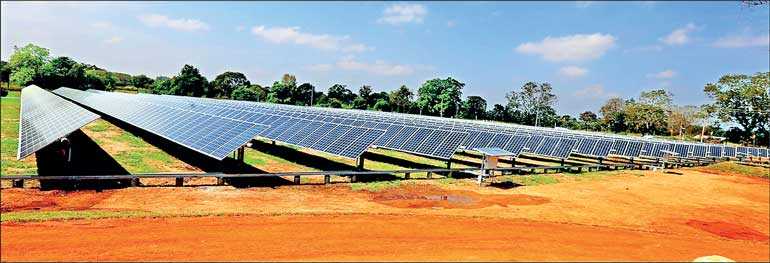Thursday Apr 24, 2025
Thursday Apr 24, 2025
Friday, 12 July 2019 00:00 - - {{hitsCtrl.values.hits}}

A few weeks back, a solar power system of 50 kW went operational at Ananda College Colombo. This is to supply electric power to its legendary Kularatne Hall. Lakdhanavi, a subsidiary of LTL Holdings (formally known as Lanka Transformers Ltd.) supplied and installed the equipment as a CSR initiative, one in a series of such similar projects it carries out islandwide. 
Manohara Thilakawardene, then on LTL Holdings Board, U.D. Jayawardana, LTL Holdings Chief Executive Officer, and Dammika Nanayakkara, Chief Operations Officer, have been instrumental in implementing this system for the premier Buddhist education institute of the nation.
Lakdhanavi, as its website says, is the largest Independent Power Producer (IPP) within the power sector of Sri Lanka. It claims many impressive achievements. Since its inception in 1997 it has been the premier Engineering, Procurement and Construction (EPC) contractor in the sector too. The company is well-known for major power projects, including power generating stations and emergency power stations.
Lakdhanavi is also a dynamic player in manufacturing, construction and service industry which spans electrical, mechanical and civil engineering fields. With its experienced and professional team of engineers, Lakdhanavi handles full scope of projects from design, to procurement, right through to commissioning. Within a short span of a decade, it has completed six power projects, including the 300 MW cycle power plant in Kerawalapitiya.
Through Infra and Engineering Ltd., a subsidiary, it is engaged in EPC and operations and management operations overseas, it now focuses on satisfying the demands of foreign clientele. Lakdhanavi is currently engaged in developing 114 MW power plant in Feni Bangladesh. This is one firm which makes us truly proud.
Why this system?
Why this system? Like most Colombo national schools, Ananda College spends heavily on providing advanced education facilities for its students. They cannot only be funded through donations by old boys and well-wishers and facility fees of students (about Rs. 6,000 per student a year). The annual electricity bill itself runs in to couple of millions. If this system provides power for eight hours continuously a day for 250 days per year, at Rs. 20 per unit, it can save about Rs. 2 million for the school.
During school vacations it can supply extra production to the national grid and being compensated for it by Ceylon Electricity Board. These will ease the college administrative burden, no doubt. This was not the only reason why this system came into place. A parallel objective was to educate about and familiarise Ananda students to the renewable energy culture – particularly with regard to solar energy.
Cost of solar electricity has been rapidly falling with a parallel increase in the number of grid-connected solar photovoltaic systems (several millions now worldwide) and utility-scale photovoltaic power stations that produce hundreds of megawatts. Solar photovoltaic systems are rapidly becoming an inexpensive, low-carbon technology to harness renewable energy from the sun. The solar energy industry is poised to assume a bigger role in global energy markets; as it evolves its impact on businesses and consumers will be significant and widespread.
The current largest photovoltaic power station in the world is the 850 MW Longyangxia Dam Solar Park, in Qinghai, China. According to the International Energy Agency projection in 2014 under its ‘high renewables’ scenario, by 2050, solar photovoltaic and concentrated solar power would contribute about 16% and 11% respectively, of worldwide electricity consumption, and solar would be the world’s largest source of electricity with most solar installations would be in China and India. In 2017, solar power provided 1.7% of total worldwide electricity production, growing at 35% per annum.
A unique opportunity
In addition to obvious environmental benefits, solar energy is sure to bring about major economic and social gains. The creation of a solar energy system offers a unique opportunity to release industrial society from the possible harmful consequences of the Industrial Revolution and to make available its positive accomplishments — particularly the social, democratic and cultural opportunities made possible by freeing mankind from slave labour — to all of mankind.
On the other hand, fossil fuels not only are non-renewable, but they are also a cause of various adverse environmental effects. Burning fossil fuels is the leading producer of, inter alia, carbon dioxide, which has contributed significantly to climate change. Notable effects include global warming, melting ice in the Arctic, rising sea levels and poor crop yields.
It has been estimated that annual costs of burning fossil fuels in the USA only is $ 120 billion. This is mostly due to health issues created by air pollution. In Europe aggregate costs are even higher and have reached $ 1.6 trillion a year. Combining expenditures on fossil fuels, healthcare costs, and environmental degradation, it is estimated true cost of fossil fuels can be as high as $ 6 trillion a year globally. That is roughly $ 1,000 per an individual.
Surya Bala Sangramaya and its benefits
Surya Bala Sangramaya, the solar energy initiative of the Ministry of Power and Renewable Energy, was launched in 2015 in this backdrop. The objective was not just to replace power from fossil fuel with that from solar but to make more than one million families both consumers as well as producers. They will have an opportunity to earn an additional income by converting as electricity producers selling excess electricity produce to national grid. The following could be the direct benefits to the nation:
One key policy that drove Surya Bala Sangramaya from its inception is transparency. The first round of projects producing an aggregate power of 200 MW and producing 10,000 jobs – a rise from a mere 500 within three years – was a huge success only because of this policy.
The Ministry of Power and Renewable Energy has guaranteed tenders were promptly called and awarded for the most suitable parties. If one manipulated procurement process, this quick success would never have been achieved. Also noteworthy: There were no complaints at all on the procedure. This was a true triumph.
Given the weather issues we face now, Ceylon Electricity Board (CEB) still struggles to provide uninterrupted power. A quick addition of solar power to the system, in that backdrop, does no harm but only good.
Continuing Surya Bala Sangramaya is a national need
We spend heavily – as a supplement to national budget – on purchasing emergency power from private parties. On the other hand, solar energy industry has claimed capacity to add 500 MW-600 MW of power to the national grid in six months, with smaller plants able to come online even faster. So we guess this is the right time to take Surya Bala Sangramaya to next level, from the point it was stalled, to meet industry and country needs. If we do those additions fast enough, the industry has also claimed generation would be uninterrupted for 20-25 years. So why not? Are we just going to sit and wait till our energy costs skyrocket?
Continuing Surya Bala Sangramaya is a national need. It must happen irrespective of the powers. As it can never be a success without private sector contribution, a level playing field for all is a must. Any energy provider should be able to compete in a free market, in the most transparent manner, be it big or small.
The Ceylon Electricity Board (CEB), a fully State-owned body, cannot have any interests other than the interest of the State and public. What the public looks for is low cost and clean energy. We have already shown the way forward. So it wouldn’t be a difficult task for the Surya Bala Sangramaya program to move ahead confidentially, providing the best for the people. That is exactly what the nation expects.
(Ajith P. Perera is the Minister of Digital Infrastructure and Information Technology while Chanuka Wattegama is a prominent business writer.)
Discover Kapruka, the leading online shopping platform in Sri Lanka, where you can conveniently send Gifts and Flowers to your loved ones for any event including Valentine ’s Day. Explore a wide range of popular Shopping Categories on Kapruka, including Toys, Groceries, Electronics, Birthday Cakes, Fruits, Chocolates, Flower Bouquets, Clothing, Watches, Lingerie, Gift Sets and Jewellery. Also if you’re interested in selling with Kapruka, Partner Central by Kapruka is the best solution to start with. Moreover, through Kapruka Global Shop, you can also enjoy the convenience of purchasing products from renowned platforms like Amazon and eBay and have them delivered to Sri Lanka.
Discover Kapruka, the leading online shopping platform in Sri Lanka, where you can conveniently send Gifts and Flowers to your loved ones for any event including Valentine ’s Day. Explore a wide range of popular Shopping Categories on Kapruka, including Toys, Groceries, Electronics, Birthday Cakes, Fruits, Chocolates, Flower Bouquets, Clothing, Watches, Lingerie, Gift Sets and Jewellery. Also if you’re interested in selling with Kapruka, Partner Central by Kapruka is the best solution to start with. Moreover, through Kapruka Global Shop, you can also enjoy the convenience of purchasing products from renowned platforms like Amazon and eBay and have them delivered to Sri Lanka.